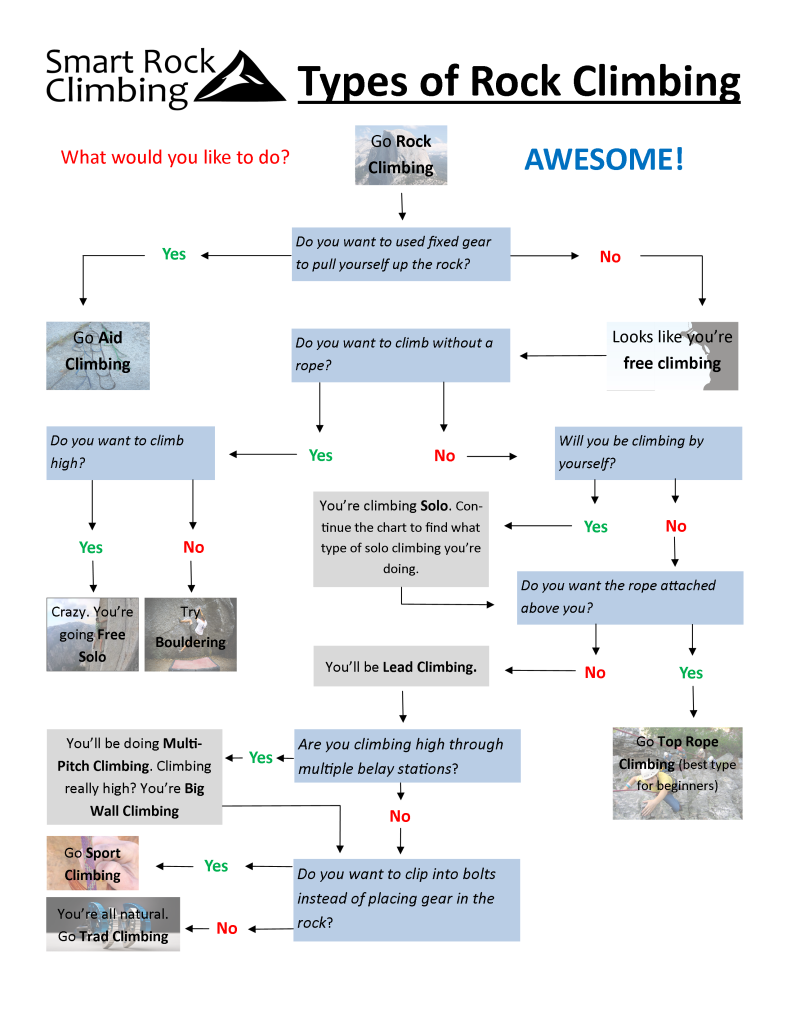If you’re wanting to make you way up a rock, there are many different types of rock climbing that you can choose from. This page will introduce you to the fundamentals of top rope climbing, sport climbing or trad climbing.
To help you understand these types, check out the video below (coming soon), or this nifty flow chart at the bottom of the page.
A Quick Overview of the Types of Climbing
To help keep things straight, here is a list of the different types of climbing that you can choose from as you approach the rock.
Aid climbing: Using gear to hold a climbers weight as they go up a wall. You use the gear to hold yourself or to pull yourself up the rock.
Big Wall Climbing: Climbing a longer route that requires multiple pitches to climb. Big wall climbs can take several days to do.
Bouldering: Climbing at low heights without a rope. Climbers will use spotters and crash pads to help them stay safe while climbing.
Free Climbing: Climbing by using the rock to climb up. Free climbing does not use artificial aids to get you up the rock, but you can still use gear for safety (you’re just not pulling on the gear to get up).
Free Solo: Climbing high without a rope.
Lead Climbing: Putting in gear into the rock as you are climbing up the wall.
Multi-Pitch: Climbing up a wall using multiple belay stations. This allows the climbing group to go higher than they can with one length of rope.
Simul Climbing (not mentioned in the video): A style where climbers “move together”, a risky but speedy technique. Both leader and second move at the same time without stopping to belay.
Solo Climbing: Climbing without the assistance of a partner. There are several ways to solo climb including top rope solo, lead solo, and free solo.
Sport Climbing: Lead climbing by attaching quickdraws to bolts while going up a wall.
Top Rope: Setting up the anchor before climbing. Usually hiking to the anchor.
Traditional (Trad) Climbing: Climbing by placing gear in cracks as you climb.
The Climbing Type Flow Chart
With so many types of rock climbing to choose from, I thought it might be helpful to create a simple decision chart that would help you choose the right climb for you.
Based upon your answer to the questions in the flow chart, you will come to a decision of the perfect type of climbing for you.

Something to note on the chart is that the grey boxes, though they are not your final stopping point, help to give further definition to the climb you choose. For example, you can do a multi-pitch sport climb or a top rope solo climb.
PS. If you want to sound hard core, just sat that you free climbed to your non-climbing friends (even if you did top rope climbing). Their lack of understanding of climbing terminology will give you a shining moment of glory (until they see this flow chart.
[cjtoolbox name=’Like what youve read – Page Bottom Opt In’ ] [/cjtoolbox]
Share:
